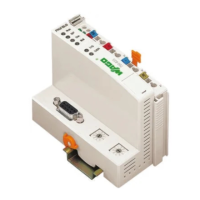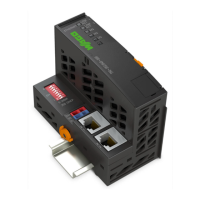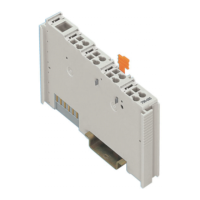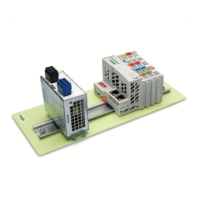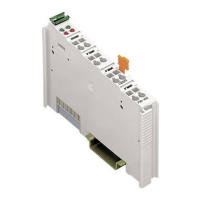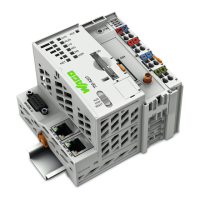Fieldbus Communication • 197
ETHERNET
WAGO-I/O-SYSTEM 750
Linux Fieldbus Coupler
5-4-3 Rule
A consideration in setting up a tree topology using ETHERNET protocol is the
5-4-3 rule. One aspect of the ETHERNET protocol requires that a signal sent
out on the network cable must reach every part of the network within a
specified length of time. Each concentrator or repeater that a signal goes
through adds a small amount of time. This leads to the rule that between any
two nodes on the network there can only be a maximum of 5 segments
connected through 4 repeators/concentrators. In addition, only 3 of the
segments may be populated (trunk) segments if they are made of coaxial
cable. A populated segment is one that has one or more nodes attached to it. In
Figure 5-5, the 5-4-3 rule is adhered to. The furthest two nodes on the network
have 4 segments and 3 repeators/concentrators between them.
This rule does not apply to other network protocols or ETHERNET networks
where all fiber optic cabling or a combination of a backbone with UTP cabling
is used. If there is a combination of fiber optic backbone and UTP cabling, the
rule is simply translated to 7-6-5 rule.
Cabling guidelines
"Structured Cabling" specifies general guidelines for network architecture of a
LAN, establishing maximum cable lengths for the grounds area, building and
floor cabling.
The "Structured Cabling" is standardized in EN 50173, ISO 11801 and TIA
568-A. It forms the basis for a future-orientated, application-independent and
cost-effective network infrastructure.
The cabling standards define a domain covering a geographical area of 3 km
and for an office area of up to 1 million square meters with 50 to 50,000
terminals. In addition, they describe recommendations for setting up of a
cabling system.
Specifications may vary depending on the selected topology, the transmission
media and coupler modules used in industrial environments, as well as the use
of components from different manufacturers in a network. Therefore, the
specifications given here are only intended as recommendations.

